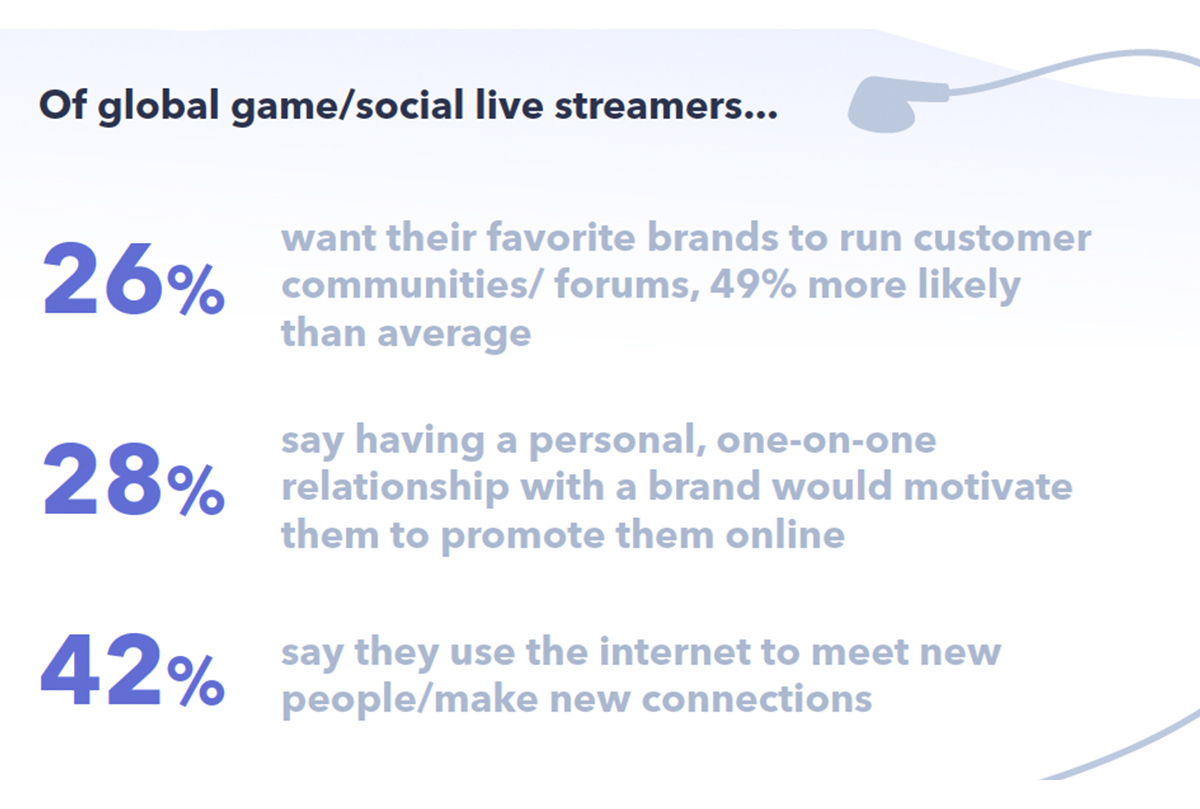
If ever there was an era perfect for a live streaming boom – this is it. As the world sits at home to wait out the coronavirus, we’re cooking more, reading more, even napping more. We’re also streaming media by the bushel – across the nation and generations.
GlobalWebIndex, a market research SaaS company that shares audience insight with marketers, media agencies, and publishers globally, took a look recently at live streaming. GWI composed a picture of today’s live streamer, who consumes and streams video on social media – and the array of ways live streaming is increasingly popular, not just as a diversion, but an avenue to real-life parts of modern life.
If you’ve done any of these activities, you’re a live streamer:
- Checked out an Instagram Live or Facebook Live event
- Sent a Snap to a live story on Snapchat
- Produced a real-time YouTube video
Globally, excluding China, nearly 3 in 10 internet users engaged in one of these in the past month. Also:
13%: Watched a live gaming stream
Video game streaming hit the scene in the mid-2010s on Twitch. Today, Facebook, YouTube, and other services host streams in which gamers record as they play for a live audience online.
10%: Shared an image or video of their gameplay online
All a gamer needs is a strong internet connection and video editing tools. Enthusiasts will watch videos and share images of theirs or others’ gameplay online.
10%: Watched an esports tournament (video game competitions)
Take me out to the ballgame? That’s so 2019. Today, video game tournaments are big business, with passionate followers and hefty purses. Marquee events include the League of Legends World Championship, the Fortnite World Cup, and The International 10.
5%: Broadcast a live stream of their gameplay
Share your gameplay – including your reactions as you play – with the world. Gamers will tune in to see you challenge that last boss, as they say.
Gaming is just part of the live-stream revolution, along with social streaming. They sometimes overlap. Non-gaming streamers now also have a wide range of choices for consuming content on their enabled devices, from video clips to entire TV series seasons.
Marlee Font is an HR professional in Yorktown, Va. Family life for Marlee includes plenty of streaming on popular platforms such as:
“There are regular selections we watch on FiOS,” says Marlee, referring to the fiber-optic network for super-fast content delivery. “We even catch some YouTube content, too. As far as creating content, not us. We are more media consumers than contributors.”
Snapshot of global live streamers
Some 34% of global internet users are gaming or social live streamers. Of those, 41% are female. Wondershare Filmora produces a video editor that streamers use to create content. On its blog in June, it reported that Twitch, an Amazon subsidiary and video live streaming service, has 2.2 million active broadcasters monthly.
Although that burgeoning demographic has its share of members, another form of live streaming – on social media – reaches a broader audience of age groups.
The 25-34 age group led generations in the percentage who live stream (26%), with those just above (35-44, 24%) and below (16-25, 25%) not far behind. Even those 45-54 (20%) and 55-64 (17%) weren’t miles behind. For gamers, percentages are lower across the board. Only 4% of the 55-64 age group were live game streamers. The conclusion: Even with big numbers of participants, game streamers are still less prominent than social streamers.
Only in Asia did game streamers outpace social streamers globally.

We know who they are – now, what do they want?
We know streamers are out there, watching, gaming, and sharing. What’s the end game? For some, it’s just to be. Others would like to wield a little influence while they’re at it and become involved with the brands they support.
Christine Martin is a director of growth and development in Raleigh N.C. She’s a frequent live streamer, consuming or producing content 10-12 weekly. Influencing people and supporting brands are on her radar.
“It’s a fair mixture of both,” Christine says. “We are always prospecting leads and talent; however, we are adamant about uplifting and edifying our partners and nonprofits as well.”
Live streamers tend to see the internet as more than a content source, but also to interact with brands and people. They can be part of an influencer marketing trend, lending their voice and following to brands they interact with in the form of shared posts, uploaded images and videos to a brand’s social page, and ideas provided for new products and design improvements.
GWI data suggests this demographic also is likely to read branded blogs and interact with brands on messaging apps. Brands must recognize these active participants because they hold sway in an online community. They’re online to make connections and stand behind the brands they believe in.

Overall, game live streamers focus on community; social live streamers want to stand out. GWI questions to both groups revealed prevailing attitudes. These statements best sum up where mindsets are for both.
Gaming live streamers say:
I tend to buy brands I see advertised – 57%
I would buy a product to be part of the community around it – 49%
I am comfortable borrowing money – 40%
Social live streamers say:
I pursue a life of challenge, novelty, and change – 71%
I am a risk-taker – 59%
I like to stand out in a crowd – 52%
Not all live streamers leave such a big social media footprint. Some, like Marlee Font, live stream, but keep their private life private.
“I do watch a few live streams on Facebook from time to time, but not very often,” Marlee says. “I am a huge Disney fan, so the majority of my social media use is to get updates on what is going on in the magical world of Disney.”
Don’t mistake some live streamers’ extroverted style for arrogance. Social live streamers are 87% more likely than average to use social media to promote and support charities.
How did coronavirus impact all of this?
We made it this far without mentioning COVID-19 – but it has made its mark on live streaming, especially in the U.S. and United Kingdom. Those nations suffered a dearth of sporting and other entertainment events as communities quarantined to prevent infection spikes.
This pandemic left a void in events that would draw a crowd, making social distancing impossible, and the disregard for it careless. Live streamers in the U.S. and U.K. were more likely than internet users who don’t stream to have attended a group event in the past 2 months.
Live streamers surpassed internet users who don’t stream 27% to 16% in education and training sessions, 24%-14% in concerts and festivals, and 22%-13% in fitness classes.
Half of the internet users in those nations value online interactions as highly as they do those in person. They also want their streaming experiences to replicate as closely as possible the feel of attending in person.
“It needs clarity, consistency, and contact,” Christine Martin says. “I need to be able to see and hear it well. I need to be able to rely on it and I need to be able to engage with it.”
Their biggest asks: To consume, add-free (33%), to watch in high-definition (36%), and see their favorite performers (38%).
Give that to them, and – especially Gen Z and Millennials – will deploy quickly in support, through donations, purchases, and social clout. Gen Zs are 63% more likely than average to seek an option to donate directly to support performers. Give them a DONATE button.
And, 29% of Millennials want to share experiences – good or bad – with their friends. That’s 24% higher than the average internet user. It’s at their fingertips, 24/7, yet sometimes it’s fine to reach out, old-school. Like a simple video chat.
“We had just really gotten underway with a newer D&D campaign, when “the rona” hit,” Marlee said. “So we wanted to keep the momentum rolling and not hit the [PAUSE] button, especially with not knowing how long until we could resume ‘normal operations.’”
Sources: GlobalWebIndex, Filmora Wondershare, Repeat
By subscribing to our newsletter, you agree to our Privacy Policy.




